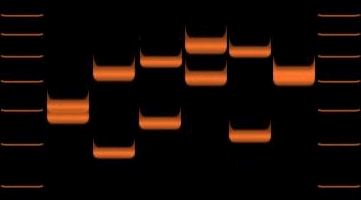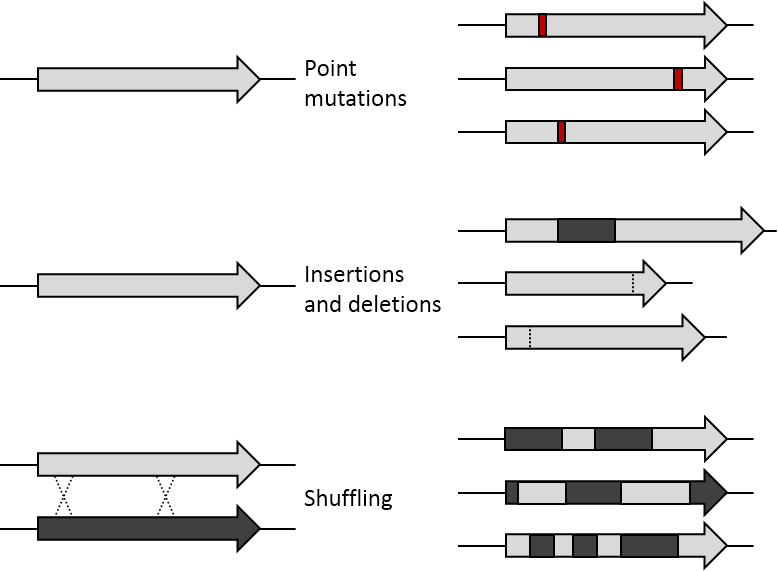|
Asymmetric PCR
Asymmetric PCR is a variation of PCR used to preferentially amplify one strand of the original DNA more than the other. The technique has applications in some types of sequencing and hybridization probing where having only one of the two complementary strands is required. Methodology Asymmetric PCR differs from regular PCR by the excessive amount of primers for a chosen strand. Due to the slow (arithmetic) amplification later in the reaction (after the limiting primer has been used up) extra cycles of PCR are required. A modification on this process, known as Linear-After-The-Exponential-PCR (LATE-PCR), uses a limiting primer with a higher melting temperature than the excess primer to maintain reaction efficiency as the limiting primer concentration decreases mid-reaction. Applications Asymmetric PCR can be used to form single stranded DNA from double stranded DNA, which is then used for DNA sequencing in the mutagenesis method. Single stranded DNA is also important for apt ... [...More Info...] [...Related Items...] OR: [Wikipedia] [Google] [Baidu] |
Polymerase Chain Reaction
The polymerase chain reaction (PCR) is a method widely used to rapidly make millions to billions of copies (complete or partial) of a specific DNA sample, allowing scientists to take a very small sample of DNA and amplify it (or a part of it) to a large enough amount to study in detail. PCR was invented in 1983 by the American biochemist Kary Mullis at Cetus Corporation; Mullis and biochemist Michael Smith (chemist), Michael Smith, who had developed other essential ways of manipulating DNA, were jointly awarded the Nobel Prize in Chemistry in 1993. PCR is fundamental to many of the procedures used in genetic testing and research, including analysis of Ancient DNA, ancient samples of DNA and identification of infectious agents. Using PCR, copies of very small amounts of DNA sequences are exponentially amplified in a series of cycles of temperature changes. PCR is now a common and often indispensable technique used in medical laboratory research for a broad variety of applications ... [...More Info...] [...Related Items...] OR: [Wikipedia] [Google] [Baidu] |
Sequencing
In genetics and biochemistry, sequencing means to determine the primary structure (sometimes incorrectly called the primary sequence) of an unbranched biopolymer. Sequencing results in a symbolic linear depiction known as a sequence which succinctly summarizes much of the atomic-level structure of the sequenced molecule. DNA sequencing DNA sequencing is the process of determining the nucleotide order of a given DNA fragment. So far, most DNA sequencing has been performed using the chain termination method developed by Frederick Sanger. This technique uses sequence-specific termination of a DNA synthesis reaction using modified nucleotide substrates. However, new sequencing technologies such as pyrosequencing are gaining an increasing share of the sequencing market. More genome data are now being produced by pyrosequencing than Sanger DNA sequencing. Pyrosequencing has enabled rapid genome sequencing. Bacterial genomes can be sequenced in a single run with several times cover ... [...More Info...] [...Related Items...] OR: [Wikipedia] [Google] [Baidu] |
Hybridization Probe
In molecular biology, a hybridization probe (HP) is a fragment of DNA or RNA of usually 15–10000 nucleotide long which can be radioactively or fluorescently labeled. HP can be used to detect the presence of nucleotide sequences in analyzed RNA or DNA that are complementary to the sequence in the probe. The labeled probe is first denatured (by heating or under alkaline conditions such as exposure to sodium hydroxide) into single stranded DNA (ssDNA) and then hybridized to the target ssDNA ( Southern blotting) or RNA (northern blotting) immobilized on a membrane or in situ. To detect hybridization of the probe to its target sequence, the probe is tagged (or "labeled") with a molecular marker of either radioactive or (more recently) fluorescent molecules. Commonly used markers are 32P (a radioactive isotope of phosphorus incorporated into the phosphodiester bond in the probe DNA), digoxigenin, a non-radioactive, antibody-based marker, biotin or fluorescein. DNA sequences o ... [...More Info...] [...Related Items...] OR: [Wikipedia] [Google] [Baidu] |
Coding Strand
When referring to DNA transcription, the coding strand (or informational strand) is the DNA strand whose base sequence is identical to the base sequence of the RNA transcript produced (although with thymine replaced by uracil). It is this strand which contains codons, while the non-coding strand contains anticodons. During transcription, RNA Pol II binds to the non-coding template strand, reads the anti-codons, and transcribes their sequence to synthesize an RNA transcript with complementary bases. By convention, the coding strand is the strand used when displaying a DNA sequence. It is presented in the 5' to 3' direction. Wherever a gene exists on a DNA molecule, one strand is the coding strand (or sense strand), and the other is the noncoding strand (also called the antisense strand, anticoding strand, template strand or transcribed strand). Strands in transcription bubble During transcription, RNA polymerase unwinds a short section of the DNA double helix near the start o ... [...More Info...] [...Related Items...] OR: [Wikipedia] [Google] [Baidu] |
Primer (molecular Biology)
Primer may refer to: Arts, entertainment, and media Films * ''Primer'' (film), a 2004 feature film written and directed by Shane Carruth * ''Primer'' (video), a documentary about the funk band Living Colour Literature * Primer (textbook), a textbook used in primary education to teach the alphabet and other basic subjects * Primer (prayer book), a common name for English prayer books used from the 13th to 16th centuries * ''The New England Primer'' (1688), a Puritan book from Colonial America with morality-themed rhymes Music * ''Primer'' (album), a 1995 music album by the musical group Rockapella * Primer 55, an American alternative metal band * "The Primer", a song from the 2005 album ''Alaska'' by Between the Buried and Me Firearms * Primer (firearms), a firearm powder charge-ignition mechanism ** Centerfire ammunition, Boxer or Berdan primers used in modern centerfire cartridges ** Detonator, a small explosive device also known as an explosive primer or blasting cap ** Fr ... [...More Info...] [...Related Items...] OR: [Wikipedia] [Google] [Baidu] |
Variants Of PCR
The versatility of polymerase chain reaction (PCR) has led to a large number of variants of PCR. Basic modifications Often only a small modification needs to be made to the standard PCR protocol to achieve a desired goal: ''Multiplex-PCR'' uses several pairs of primers annealing to different target sequences. This permits the simultaneous analysis of multiple targets in a single sample. For example, in testing for genetic mutations, six or more amplifications might be combined. In the standard protocol for DNA Fingerprinting, the targets assayed are often amplified in groups of 3 or 4. ''Multiplex Ligation-dependent Probe Amplification'' (or ''Multiplex Ligation-dependent Probe Amplification, MLPA'') permits multiple targets to be amplified using only a single pair of primers, avoiding the resolution limitations of multiplex PCR. Multiplex PCR has also been used for analysis of Microsatellite (genetics), microsatellites and single nucleotide polymorphism, SNPs. ''Variable N ... [...More Info...] [...Related Items...] OR: [Wikipedia] [Google] [Baidu] |
Nucleic Acid Thermodynamics
Nucleic acid thermodynamics is the study of how temperature affects the nucleic acid structure of double-stranded DNA (dsDNA). The melting temperature (''Tm'') is defined as the temperature at which half of the DNA strands are in the random coil or single-stranded (ssDNA) state. ''Tm'' depends on the length of the DNA molecule and its specific nucleotide sequence. DNA, when in a state where its two strands are dissociated (i.e., the dsDNA molecule exists as two independent strands), is referred to as having been denatured by the high temperature. Concepts Hybridization Hybridization is the process of establishing a non-covalent, sequence-specific interaction between two or more complementary strands of nucleic acids into a single complex, which in the case of two strands is referred to as a duplex. Oligonucleotides, DNA, or RNA will bind to their complement under normal conditions, so two perfectly complementary strands will bind to each other readily. In order to reduce the d ... [...More Info...] [...Related Items...] OR: [Wikipedia] [Google] [Baidu] |
Mutagenesis (molecular Biology Technique)
In molecular biology, mutagenesis is an important laboratory technique whereby DNA mutations are deliberately engineered to produce libraries of mutant genes, proteins, strains of bacteria, or other genetically modified organisms. The various constituents of a gene, as well as its regulatory elements and its gene products, may be mutated so that the functioning of a genetic locus, process, or product can be examined in detail. The mutation may produce mutant proteins with interesting properties or enhanced or novel functions that may be of commercial use. Mutant strains may also be produced that have practical application or allow the molecular basis of a particular cell function to be investigated. Many methods of mutagenesis exist today. Initially, the kind of mutations artificially induced in the laboratory were entirely random using mechanisms such as UV irradiation. Random mutagenesis cannot target specific regions or sequences of the genome; however, with the development ... [...More Info...] [...Related Items...] OR: [Wikipedia] [Google] [Baidu] |
Aptamer
Aptamers are short sequences of artificial DNA, RNA, XNA, or peptide that bind a specific target molecule, or family of target molecules. They exhibit a range of affinities ( KD in the pM to μM range), with little or no off-target binding and are sometimes classified as chemical antibodies. Aptamers and antibodies can be used in many of the same applications, but the nucleic acid-based structure of aptamers, which are mostly oligonucleotides, is very different from the amino acid-based structure of antibodies, which are proteins. This difference can make aptamers a better choice than antibodies for some purposes (see antibody replacement). Aptamers are used in biological lab research and medical tests. If multiple aptamers are combined into a single assay, they can measure large numbers of different proteins in a sample. They can be used to identify molecular markers of disease, or can function as drugs, drug delivery systems and controlled drug release systems. They a ... [...More Info...] [...Related Items...] OR: [Wikipedia] [Google] [Baidu] |




